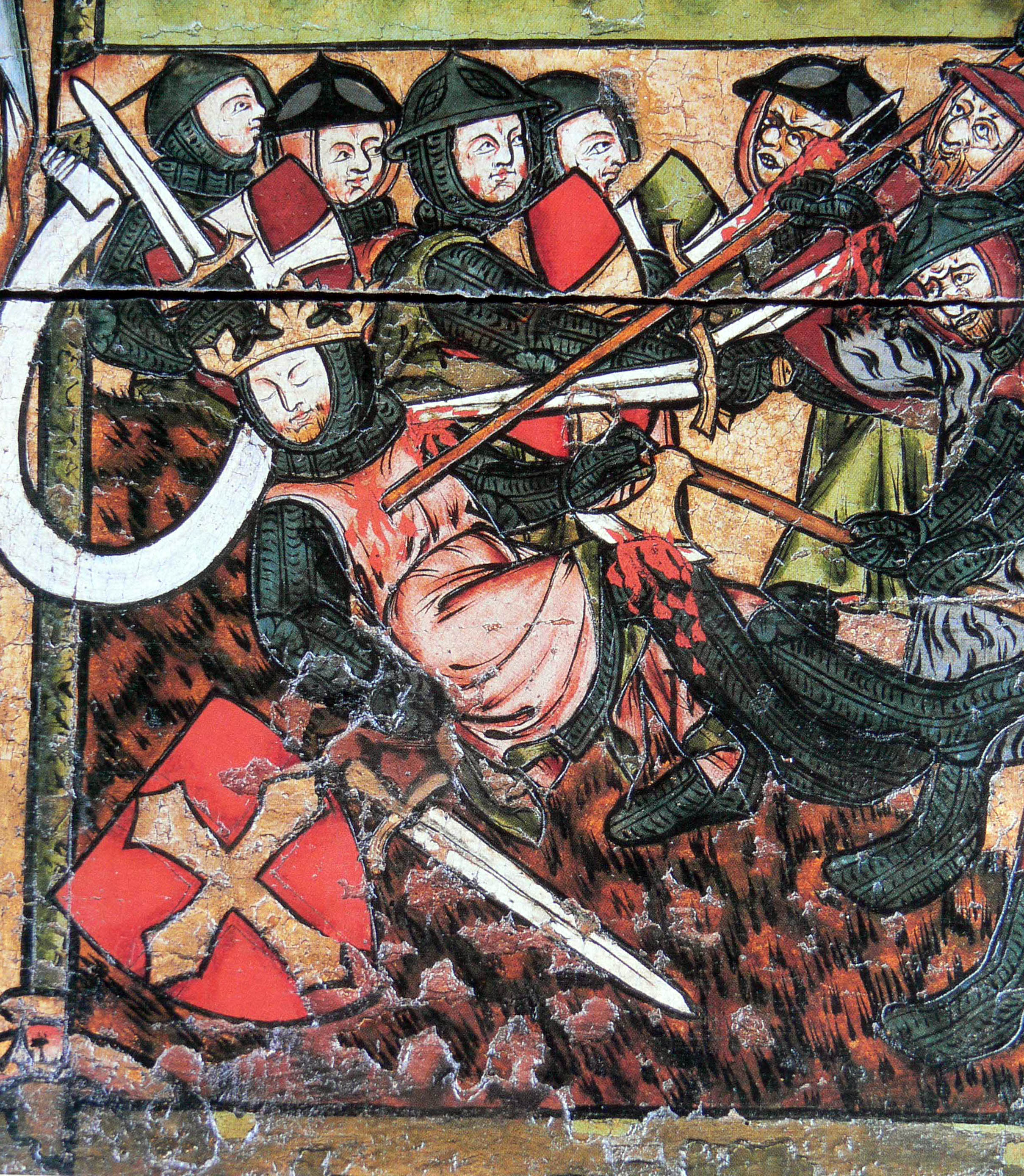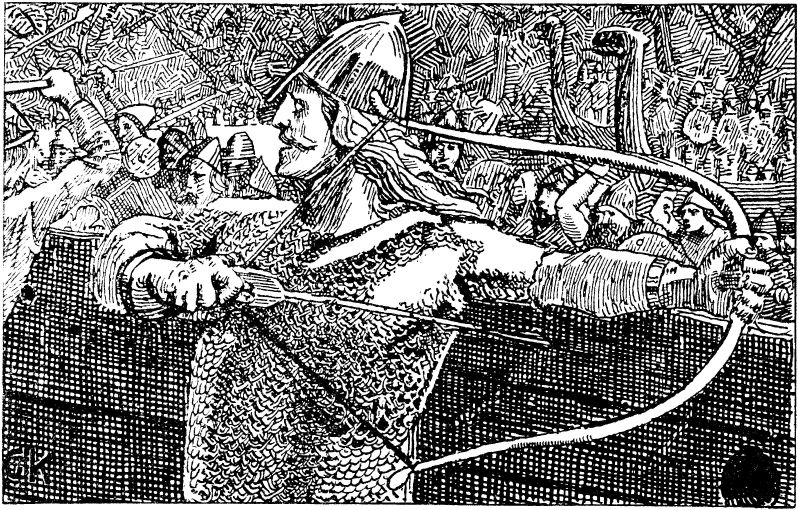|
Tore Hund
Modern and imaginary presentation of Tore Hund Thorir Hund (Old Norse: Þórir hundr, Modern Norwegian: ''Tore Hund'', literally "''Thorir the Hound''") (born ca. 990) was one of the greatest chiefs in Hålogaland. Tore Hund was one of the leaders of the Stiklestad peasant faction opposing Norwegian King Olaf II of Norway, later named St. Olaf. He was reported to have been among the chieftains who killed the king in the Battle of Stiklestad in 1030. He also served in the forces of King Canute the Great on several occasions."Tore Hund" '''' Background Thorir Hund was born at the beginning of the |
Viking
Vikings ; non, víkingr is the modern name given to seafaring people originally from Scandinavia (present-day Denmark, Norway and Sweden), who from the late 8th to the late 11th centuries raided, pirated, traded and settled throughout parts of Europe.Roesdahl, pp. 9–22. They also voyaged as far as the Mediterranean, North Africa, Volga Bulgaria, the Middle East, and North America. In some of the countries they raided and settled in, this period is popularly known as the Viking Age, and the term "Viking" also commonly includes the inhabitants of the Scandinavian homelands as a collective whole. The Vikings had a profound impact on the early medieval history of Scandinavia, the British Isles, France, Estonia, and Kievan Rus'. Expert sailors and navigators aboard their characteristic longships, Vikings established Norse settlements and governments in the British Isles, the Faroe Islands, Iceland, Greenland, Normandy, and the Baltic coast, as well as alon ... [...More Info...] [...Related Items...] OR: [Wikipedia] [Google] [Baidu] |
Einar Thambarskelfir
Einar Eindridesson Thambarskelfir (c. 980–c. 1050) (Old Norse: ''Einarr Þambarskelfir'', Modern Norwegian: ''Einar Tambarskjelve'') was an influential Norwegian noble and politician during the 11th century. He headed the feudal lords in their opposition to Olaf Haraldsson. Several references are made to him in Snorri Sturluson's Heimskringla. His cognomen, ''Thambarskelfir'', has two strongly differing explanations. One is that it is derived from ', meaning "shaking bowstring". Thus, the name suggests a master of the longbow. The other is that it is derived from ', meaning "belly", and that it translates to "wobbly belly", surely an unflattering reflection of his physical build. Or it could be the “belly” of the bow. Background Einarr Thambarskelfir was the son of Eindride, a rich and influential farmer at the Viking Age political center of Melhus. Einar Thambarskelfir was a jarl and chieftain at Husaby, a farm in Skaun municipality, and a powerful warlord with his o ... [...More Info...] [...Related Items...] OR: [Wikipedia] [Google] [Baidu] |
Olav Der Heilige06
Olaf or Olav (, , or British ; Old Norse: ''Áleifr'', ''Ólafr'', ''Óleifr'', ''Anleifr'') is a Scandinavian and German given name. It is presumably of Proto-Norse origin, reconstructed as ''*Anu-laibaz'', from ''anu'' "ancestor, grand-father" and ''laibaz'' "heirloom, descendant". Old English forms are attested as ''Ǣlāf'', ''Anlāf''. The corresponding Old Novgorod dialect form is ''Uleb''. A later English form of the name is ''Olave''. In the Norwegian language, ''Olav'' and ''Olaf'' are equally common, but Olav is traditionally used when referring to Norwegian royalty. The Swedish form is '' Olov'' or ''Olof'', and the Danish form is ''Oluf''. It was borrowed into Old Irish and Scots with the spellings ''Amlaíb'' and ''Amhlaoibh'', giving rise to modern version '' Aulay''. The name is Latinized as ''Olaus''. Notable people North Germanic ;Denmark *Olaf I of Denmark, king 1086–1095 * Olaf II of Denmark, also Olaf IV of Norway * Oluf Haraldsen (died c. 1143), Dan ... [...More Info...] [...Related Items...] OR: [Wikipedia] [Google] [Baidu] |
Harald Hardrada
Harald Sigurdsson (; – 25 September 1066), also known as Harald III of Norway and given the epithet ''Hardrada'' (; modern no, Hardråde, roughly translated as "stern counsel" or "hard ruler") in the sagas, was King of Norway from 1046 to 1066. Additionally, he unsuccessfully claimed both the Danish throne until 1064 and the English throne in 1066. Before becoming king, Harald had spent around fifteen years in exile as a mercenary and military commander in Kievan Rus' and as a chief of the Varangian Guard in the Byzantine Empire. When he was fifteen years old, in 1030, Harald fought in the Battle of Stiklestad together with his half-brother Olaf Haraldsson (later Saint Olaf). Olaf sought to reclaim the Norwegian throne, which he had lost to the Danish king Cnut the Great two years prior. In the battle, Olaf and Harald were defeated by forces loyal to Cnut, and Harald was forced into exile to Kievan Rus' (the sagas' ). He thereafter spent some time in the army of Grand P ... [...More Info...] [...Related Items...] OR: [Wikipedia] [Google] [Baidu] |
Rogaland
Rogaland () is a county in Western Norway, bordering the North Sea to the west and the counties of Vestland to the north, Vestfold og Telemark to the east and Agder to the east and southeast. In 2020, it had a population of 479,892. The administrative centre of the county is the city of Stavanger, which is one of the largest cities in Norway. Rogaland is the centre of the Norwegian petroleum industry. In 2016, Rogaland had an unemployment rate of 4.9%, one of the highest in Norway. In 2015, Rogaland had a fertility rate of 1.78 children per woman, which is the highest in the country. The Diocese of Stavanger for the Church of Norway includes all of Rogaland county. Etymology ''Rogaland'' is the region's Old Norse name, which was revived in modern times. During Denmark's rule of Norway until the year 1814, the county was named ''Stavanger amt'', after the large city of Stavanger. The first element is the plural genitive case of ''rygir'' which is probably referring to th ... [...More Info...] [...Related Items...] OR: [Wikipedia] [Google] [Baidu] |
Sola
Sola is a municipality and a Seaside resort in Rogaland county, Norway. It is located in the traditional district of Jæren. The administrative centre of the municipality is the village of Solakrossen. Other villages include Tananger, Hålandsmarka, Sørnes, and Stenebyen. Stavanger Airport is located in Sola, just a short distance from the large Stavanger/Sandnes metropolitan area. The municipality is the 342nd largest by area out of the 356 municipalities in Norway. Sola is the 41st most populous municipality in Norway with a population of 27,568. The municipality's population density is and its population has increased by 15.5% over the previous 10-year period. In the western part of Sola, there are of long, sandy beaches facing the North Sea. With usually ample supplies of wind and waves, the sandy beaches are a popular place for windsurfing. General information The municipality of Sola was established in 1930 when the old municipality of Håland was split i ... [...More Info...] [...Related Items...] OR: [Wikipedia] [Google] [Baidu] |
Erling Skjalgsson
Erling Skjalgsson, på Sola (Sola, Rogaland, 975 – Boknafjorden, 21 December 1028, bur. Sola, Rogaland), "Rygekongen", Herse/Høvding i Rogaland, was a Norwegian political leader of the late 10th and early 11th century. He has been commonly seen as this period's foremost defender of the historic Norwegian social system. Erling fought for the traditional small, autonomous kingdoms and the þing system, against the reformists of the Fairhair family line. Background According to the Norwegian-Icelandic saga tradition Erling Skjalgsson, son of Torleiv Skjalg Ogmundsson, belonged to one of the most prominent clans in western Norway. He lived on the farm Sola in Nord-Jæren. His sister was married to Sigurd Toresson, an important chief in Trondenes and the brother of Tore Hund of Bjarkøy. Erling was established as a political front figure by the farmers of Gulaþing. They demanded that he be married to Olav Tryggvason's sister Astrid Tryggvesdatter, daughter of Tryggve Olafss ... [...More Info...] [...Related Items...] OR: [Wikipedia] [Google] [Baidu] |
Trondenes
Trondenes is an old parish and former municipality in Troms county in Norway. The municipality existed from 1838 until its dissolution in 1964. It was located along the western shore of the Vågsfjorden in what is now Harstad Municipality. Trondenes included the majority of the island of Grytøya and part of the eastern coast of the island of Hinnøya as well as some smaller islands. Located just north of the town of Harstad, the village of Trondenes was the administrative centre of the municipality. That village is also the site of the historic Trondenes Church, the northernmost medieval stone church in Norway. The Trondenes Historical Center was built in 1997 near the church to teach about the history of the area. Trondenes Fort is also located on the Trondenes peninsula. History The parish of Trondenes was established as a municipality on 1 January 1838 (see formannskapsdistrikt). The village of Harstad (population: 1,246) was declared a ladested and was the ... [...More Info...] [...Related Items...] OR: [Wikipedia] [Google] [Baidu] |
Store Norske Leksikon
The ''Great Norwegian Encyclopedia'' ( no, Store Norske Leksikon, abbreviated ''SNL''), is a Norwegian-language online encyclopedia. The online encyclopedia is among the most-read Norwegian published sites, with more than two million unique visitors per month. Paper editions 1978–2007 The ''SNL'' was created in 1978, when the two publishing houses Aschehoug and Gyldendal merged their encyclopedias and created the company Kunnskapsforlaget. Up until 1978 the two publishing houses of Aschehoug and Gyldendal, Norway's two largest, had published ' and ', respectively. The respective first editions were published in 1907–1913 (Aschehoug) and 1933–1934 (Gyldendal). The slump in sales for paper-based encyclopedias around the turn of the 21st century hit Kunnskapsforlaget hard, but a fourth edition of the paper encyclopedia was secured by a grant of ten million Norwegian kroner from the foundation Fritt Ord in 2003. The fourth edition consisted of 16 volumes, a t ... [...More Info...] [...Related Items...] OR: [Wikipedia] [Google] [Baidu] |
Arkhangelsk
Arkhangelsk (, ; rus, Арха́нгельск, p=ɐrˈxanɡʲɪlʲsk), also known in English as Archangel and Archangelsk, is a city and the administrative center of Arkhangelsk Oblast, Russia. It lies on both banks of the Northern Dvina near its mouth into the White Sea. The city spreads for over along the banks of the river and numerous islands of its delta. Arkhangelsk was the chief seaport of medieval and early modern Russia until 1703, when it was replaced by the newly-founded Saint Petersburg. A railway runs from Arkhangelsk to Moscow via Vologda and Yaroslavl, and air travel is served by the Talagi Airport and the smaller Vaskovo Airport. As of the 2021 Census, the city's population was 301,199. Coat of arms The arms of the city display the Archangel Michael in the act of defeating the Devil. Legend states that this victory took place near where the city stands, hence its name, and that Michael still stands watch over the city to prevent the Devil's return. His ... [...More Info...] [...Related Items...] OR: [Wikipedia] [Google] [Baidu] |





